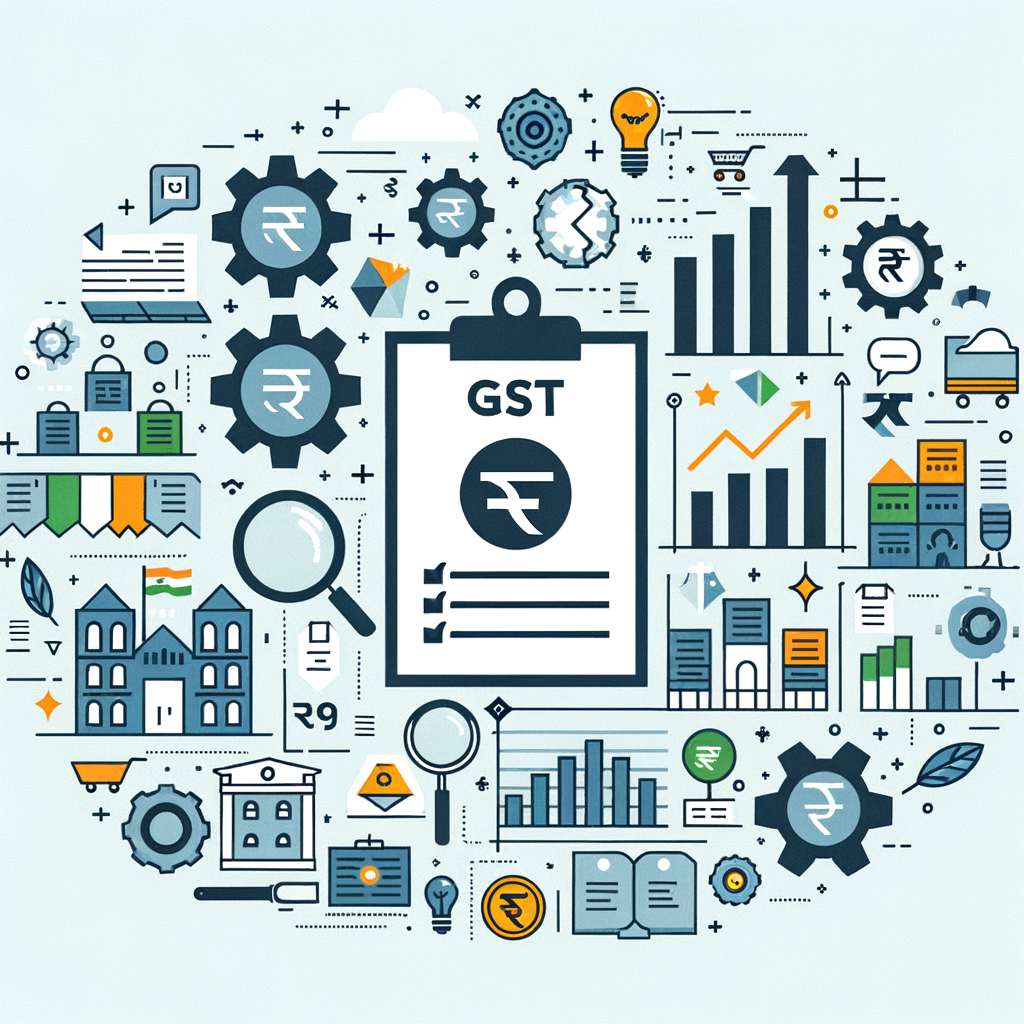How GST Affects Various Industries: Sector-Specific Compliance Tips
While the Goods and Services Tax (GST) successfully unified India’s complex tax landscape into a single system, its application is far from uniform across every business sector. For small business owners and professionals, understanding the unique challenges and requirements of their specific field is the key to staying compliant and avoiding costly errors. This comprehensive guide provides actionable industry compliance tips tailored to different sectors, helping you navigate the complexities of GST with confidence and efficiency. Understanding the nuanced GST impact on Indian industries is not just about avoiding penalties; it’s about optimizing your tax strategy, maximizing Input Tax Credit (ITC), and ensuring the smooth financial health of your enterprise.
A Quick Refresher: Core GST Concepts for Every Business
Before diving into sector-specific details, it’s essential to have a firm grasp of the fundamental GST concepts that apply to every business in India. These building blocks are the foundation of a robust compliance framework, regardless of your industry. Getting these basics right will make navigating industry-specific GST compliance significantly easier and more intuitive.
Understanding CGST, SGST, IGST, and UTGST
GST is a dual-structured tax, meaning both the Central and State governments levy tax on transactions. The type of tax charged depends on where the transaction occurs.
- CGST (Central GST): Collected by the Central Government on an intra-state sale (within the same state).
- SGST (State GST): Collected by the State Government on an intra-state sale.
- IGST (Integrated GST): Collected by the Central Government on an inter-state sale (between two different states) or on imports.
- UTGST (Union Territory GST): Collected by the Union Territory government on an intra-union territory sale.
For example, if a seller in Maharashtra sells goods worth ₹10,000 to a buyer also in Maharashtra, and the applicable GST rate is 18%, the tax would be split into 9% CGST (₹900) and 9% SGST (₹900). However, if the same seller sold the goods to a buyer in Karnataka, the transaction would attract 18% IGST (₹1,800).
The Power of Input Tax Credit (ITC)
One of the most significant benefits of GST is the concept of Input Tax Credit (ITC). ITC is the credit that a business can claim for the GST it has already paid on its inputs, such as raw materials, services, or capital goods. This mechanism is crucial for avoiding the “cascading effect,” where tax is levied on tax, ultimately inflating the cost for the end consumer.
The key condition for claiming ITC is that the purchases must be used for business purposes. Furthermore, you can only claim ITC if your supplier is GST-registered, has correctly uploaded the invoice details in their GSTR-1 return, and has paid the tax to the government.
Essential Compliance: Invoicing and Return Filing
Proper documentation is the backbone of GST compliance. Every registered business must issue a GST-compliant invoice for all sales. This invoice must contain mandatory details, including:
- Seller’s and buyer’s GSTIN (GST Identification Number)
- Invoice number and date
- HSN (Harmonized System of Nomenclature) code for goods or SAC (Services Accounting Code) for services
- Taxable value and the breakdown of CGST, SGST, or IGST
- Place of supply
Regular and accurate return filing is non-negotiable. The two most common returns for regular taxpayers are GSTR-1 (a statement of all outward supplies or sales) and GSTR-3B (a summary return for paying the tax liability). Timely filing ensures that your customers can claim ITC on your invoices and helps you avoid late fees and interest. For more details, you can always refer to the official GST Portal.
Essential Industry Compliance Tips: A Sector-by-Sector Guide
While the fundamentals of GST apply universally, certain sectors face unique challenges and have specific rules that demand special attention. Adhering to these sector-wise compliance guidelines India has established is critical for seamless operations. This section breaks down the essential industry compliance tips for some of the most common sectors in the country.
E-commerce and Online Sellers
- Key Challenge: The primary hurdles for online sellers, especially those selling goods, are mandatory GST registration from day one (the turnover threshold does not apply) and the mechanism of Tax Collected at Source (TCS). E-commerce platforms like Amazon, Flipkart, and Myntra are designated as “e-commerce operators” and are required by law to deduct TCS, typically at 1% of the net taxable value of sales made through their platform. For a full overview, see our article on GST for E-commerce Businesses: Key Considerations.
- Compliance Tip: This TCS amount is not a cost to the seller but an advance tax collected on their behalf. The e-commerce operator deposits this amount with the government and files a return called GSTR-8, which reflects the TCS deducted for each seller. It is the seller’s responsibility to reconcile the sales figures in their own books with the data reported by the e-commerce operator.
- Actionable Advice: Make it a monthly practice to download your GSTR-8 statement from the GST portal. Carefully match this with your sales records and the payment reports provided by the e-commerce platform. Any TCS deducted by the operator will appear in your Electronic Cash Ledger on the GST portal, which you can then use to pay your final GST liability. Accurate reconciliation ensures you don’t lose this valuable credit.
Manufacturing and Trading
- Key Challenge: For manufacturers and traders dealing with a wide variety of goods, the most significant challenges are the accurate classification of goods under the HSN code system and properly managing ITC on capital goods. The GST rate for a product is directly linked to its HSN code, and any error in classification can have serious financial repercussions.
- Compliance Tip: Using the correct HSN code is not just a matter of procedure; it’s a legal requirement. An incorrect code can lead to either underpayment or overpayment of tax. Underpayment can result in a demand notice from the tax authorities, along with hefty interest and penalties. Overpayment locks up your working capital and requires you to go through a cumbersome refund process.
- Actionable Advice: First, create and maintain a master file of all your products, listing their descriptions and corresponding, verified HSN codes. For capital goods (like machinery), remember that you can claim ITC. However, if you have claimed depreciation on the GST component of that asset under the Income Tax Act, you cannot claim ITC on that same tax amount. You must choose one of the two benefits. This is one of the most important
compliance strategies for Indian industriesin manufacturing.
Restaurants and Food Services
- Key Challenge: The restaurant industry operates under a unique GST structure with different rates and ITC rules, making it crucial for owners to understand their options, particularly concerning the Composition Scheme.
- Compliance Tip: Restaurants generally fall under two GST models. Understanding the difference is key to
understanding GST implications for industrieslike food service.
Feature Standard Scheme (Most Restaurants) Scheme for Specified Hotels GST Rate 5% (without ITC) 18% (with ITC) ITC Availability No. Cannot claim ITC on any inputs. Yes. Can claim ITC on inputs. Applicability Standalone restaurants, food kiosks etc. Restaurants within hotels with room tariffs > ₹7,500 - Actionable Advice: Small restaurants and eateries with an annual turnover of up to ₹1.5 Crore should carefully evaluate the Composition Scheme. Under this scheme, you pay a flat, lower rate of tax (5% for restaurants) on your turnover and have significantly simpler compliance requirements (e.g., quarterly return filing). However, the major trade-offs are that you cannot claim any ITC on your purchases and you cannot issue a tax invoice to your customers, meaning you cannot collect tax from them. For a deeper dive, our guide to Understanding the Composition Scheme Under GST is a valuable resource.
Freelancers and Service Providers
- Key Challenge: For freelancers, consultants, and other service providers, the primary compliance points revolve around understanding the GST registration threshold and correctly applying the Place of Supply rules, especially when dealing with international clients.
- Compliance Tip: The GST registration threshold for service providers is an aggregate annual turnover of ₹20 Lakhs (₹10 Lakhs for special category states). This “aggregate turnover” includes all your taxable, exempt, and export revenues from all your professional activities under the same PAN. If you provide services to clients outside India, these are considered “exports of services” and are zero-rated under GST. This means you don’t have to charge GST, but to do so legally, you must first file a Letter of Undertaking (LUT) with the GST department.
- Actionable Advice: Diligently track your total annual professional income from all sources. Once you are close to the ₹20 Lakhs limit, initiate the registration process. If you work with international clients, make it a priority to file your LUT on the GST portal at the beginning of every financial year. This simple, one-time annual compliance allows you to export your services without charging IGST, making your services more competitive globally and saving you from the hassle of claiming tax refunds later.
Common GST Pitfalls and How to Avoid Them
Knowing the rules is one thing; applying them consistently is another. Many businesses stumble on common procedural errors that can lead to notices, penalties, and blocked funds. Here’s how to avoid them.
Mismatched Invoices (GSTR-1 vs. GSTR-2A/2B)
- Problem: Your eligibility to claim ITC on a purchase is directly dependent on your supplier correctly reporting that invoice in their GSTR-1. If they enter the wrong GSTIN, invoice value, or tax amount, or if they delay their filing, that credit will not appear in your GSTR-2A/2B, making you ineligible to claim it.
- Solution: Before filing your GSTR-3B each month, reconcile your purchase register with your GSTR-2B (an auto-drafted static ITC statement). Identify any missing invoices and immediately follow up with the respective suppliers to get them corrected. Using an accounting or reconciliation software can automate this process and save hours of manual effort.
Missing Filing Deadlines
- Problem: The cost of procrastination is high under GST. Delay in filing GSTR-1 or GSTR-3B attracts a late fee, typically ₹50 per day of delay per return. More importantly, delayed payment of taxes incurs interest at a steep 18% per annum.
- Solution: Maintain a strict compliance calendar with reminders for all important GST due dates. A simple and effective solution for
navigating industry-specific GST complianceis to entrust your filings to a professional firm. At TaxRobo GST Service, our experts ensure your returns are filed accurately and on time, every time.
Incorrectly Claiming Ineligible ITC
- Problem: Section 17(5) of the CGST Act explicitly blocks ITC on certain goods and services, even if they are used for business. Common examples include expenses on food and beverages, club memberships, health insurance, and motor vehicles with a seating capacity of less than 13 people (unless you are in the business of transporting passengers or selling vehicles). Claiming ITC on these items is a frequent audit objection.
- Solution: Educate your accounting team about the list of blocked credits under Section 17(5). Our detailed article on Blocked Credits Under Section 17(5): What ITC Cannot Be Claimed? can be a useful resource. Structure your chart of accounts to clearly segregate expenses into eligible and ineligible ITC categories. When in doubt about a specific expense, it is always wise to consult a tax advisor rather than risk an incorrect claim.
Conclusion
Successful GST compliance is not a one-size-fits-all formula. It requires a deep understanding of the core principles combined with a keen awareness of the specific rules that govern your sector. By adopting these targeted industry compliance tips, businesses can move beyond simply meeting deadlines. A proactive approach to understanding GST implications for industries allows you to prevent penalties, optimize your cash flow by maximizing eligible ITC, and build a robust financial framework that supports sustainable growth.
Navigating GST can be complex. If you need help with sector-specific advice, GST registration, or timely filing, TaxRobo’s experts are here to help. Contact us today for a personalized consultation!
Frequently Asked Questions (FAQs)
Q1. Do I need GST registration if I sell services online to clients outside India and my turnover is below ₹20 Lakhs?
A: GST registration is not mandatory if your turnover from services is below ₹20 lakhs, even if you serve international clients. However, if you wish to claim refunds on the GST paid on your inputs (like software subscriptions or office rent), you would need to register voluntarily and file a Letter of Undertaking (LUT).
Q2. As a small manufacturer, is the Composition Scheme a good option for me?
A: It can be, especially if your customers are primarily end-consumers (B2C) who cannot claim ITC. The scheme simplifies compliance with a fixed, lower tax rate on your turnover. However, if your buyers are other businesses (B2B), they will prefer buying from a regular taxpayer to claim ITC, making the scheme less attractive for B2B models.
Q3. What happens if I use the wrong HSN code on an invoice?
A: Using an incorrect HSN code can lead to paying the wrong GST rate. If you pay a lower rate, you may be liable for the deficit tax along with interest and penalties during an audit. If you pay a higher rate, you will have to go through the process of claiming a refund, which can be time-consuming.
Q4. Can a salaried individual with freelance income ignore GST?
A: No. If the total freelance income from providing services exceeds ₹20 Lakhs in a financial year, GST registration becomes mandatory. Your salary income is not included in this calculation, but all receipts from your professional services or side-gigs must be aggregated to determine if you have crossed the threshold.



